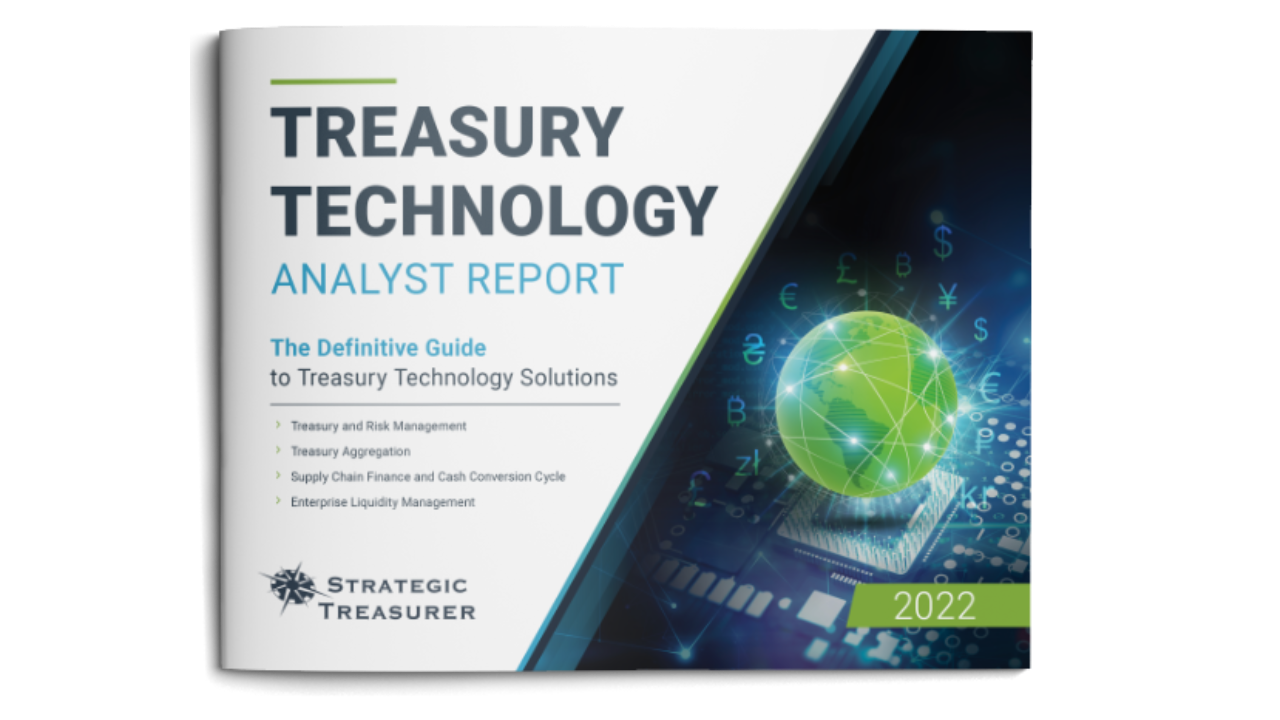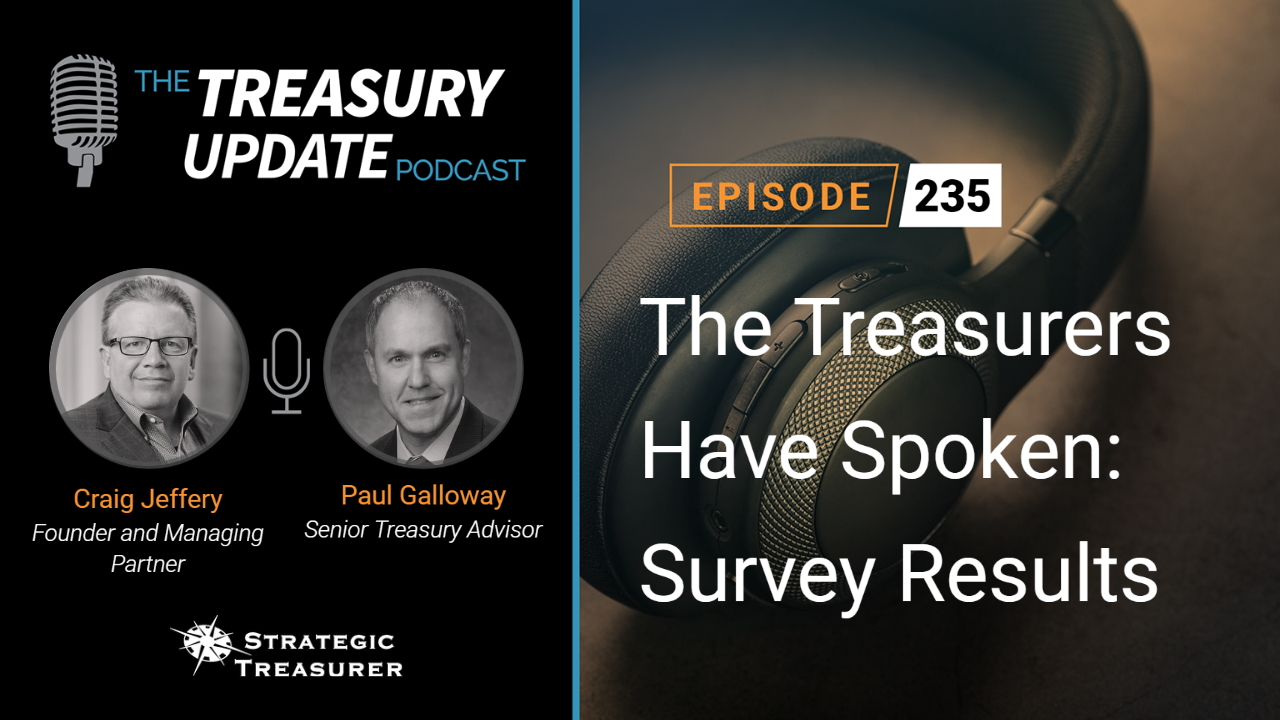
Episode 238
The Treasurers Have Spoken, Episode 3:
Survey Results on SCF & CCC Solutions
Interested in hearing more? Download our Treasury Technology Analyst Report
Host:
Craig Jeffery, Strategic Treasurer


Speaker:
Paul Galloway, Strategic Treasurer


Episode Transcription - Episode #238 - The Treasurers Have Spoken, Episode: 3 Survey Results on SCF & CCC Solutions
Announcer 00:04
Welcome to the Treasury Update Podcast presented by Strategic Treasurer, your source for interesting treasury news, analysis, and insights in your car, at the gym, or wherever you decide to tune in.
Paul Galloway 00:18
Welcome to the Treasury Update Podcast. I’m Paul Galloway, Senior Advisor, Strategic Treasurer. I’m joined by Craig Jeffery, founder and managing partner of the firm. Craig, I’d like to talk to you today about a subject I really like. It’s cash conversion cycle. You know, I’m always thinking about how you can derive more value, because that’s where I cut my teeth is on valuation analyzing businesses. So I think about cash flow. Cash conversion cycle is something that’s really important to an organization, how quickly can you receive your funds, relative to when you invoice. And so I think being able to get cash in the door quicker is something that certainly is, is a hot topic for organizations today.
Craig Jeffery 01:03
The phrase cash is king makes a lot of sense. And when you talk with people, sometimes you find out that it’s king and queen and the entire royal family, because liquidity is so vital to an organization’s strength and activities, making their business efficient. There’s a process side of that, but there’s also a capital side of that all of the best organizations pay attention to their cash conversion cycle. They optimize their working capital, even if they’re generating lots of cash. So I think I share your your interest in in this topic.
Paul Galloway 01:40
So Craig, when you think about cash conversion cycle, you know, how is it how is it defined? And why is it important?
Craig Jeffery 01:49
Well, the cash conversion cycle, and it’s usually depicted with a circle on a piece of paper, and showing you put money into the business, you buy raw materials, those get converted to goods, you sell those goods, and then you have a receivable you collect on the receivable, money comes back into the business and you pour it in. So it’s a cycle of money going into the business and coming out of it. And so there’s a there’s a process view of that. So you see it the lifecycle of that, that cycle. The other core aspect of it in terms of its definition is what why do we have a cash conversion cycle? What’s it for there’s a, there’s an element about the efficiency. So it’s the you look at the cash conversion cycle. And you have to see how quickly and how efficient you are of taking money putting into the system, and then spitting out more money at the end or hopefully more money. It’s about length and efficiency of the cycle. How do you convert it? And by looking at that there’s, there’s an understanding that all these things are connected, right? You have your cash in the bank, or you have your cash tied up in inventory. In receivables are you generating liquidity from from your payables?
Paul Galloway 03:06
You hit on some earlier in your conversation around capital? Certainly a component cash conversion cycle, when you think about organizations that are maybe more manufacturing based or supply based organizations? What is supply side financing? It’s a tool that something organizations use. But what exactly is that? What does that mean?
Craig Jeffery 03:31
Well, I’ll just begin by saying we tend to use, we essentially always use the Euro Banking Association definition, which is more broad than a number of American organizations might use. But it’s their definition is the use of financial instruments, practices and technologies to optimize the management of the working capital liquidity tied up in the supply chain processes for collaborating business partners. So sorry for reading that, quote. I don’t have it memorized. But then as that as the supply, you know, whether you’re the supplier or the customer, there’s there’s elements there where supply chain makes sense. So that’s a good definition. It’s like you’re using financial instruments. So I’ll summarize it this way, Paul, and I know you and I have talked about it before. If I’m the buyer, and you’re the seller, you’re the supplier, I’m the consumer of those, those materials. So you shipped me something, I owe it to you, well, we have terms, so I pay you and maybe our terms are 45 days, maybe they’re 30, whatever. So I paid you in 45 days, if I extend that to 50 days, I get an extra five days use of that cash, you have to front that or fun that for another five days if I if I go to 90 days. Now you’ve got to pay for and finance my operation for another 45 days. And so there’s an aspect of this normal cash conversion is when I pay you receive it’s one for one the more When the more you lose, you know, it’s a cause and effect. Supply Chain Finance, oftentimes, and there’s quite a few models, we encourage people to look at the analyst report for more description of what are some of the different options. But if I stick a financing partner in the middle, and I say I need to go to 90 days, my terms are going to be 90 days, I’m only paying in 90 days, well, now I’m paying 90 days, but that may break a number of suppliers, like all of a sudden, like, I’m gonna have to front all my receivables for another month and a half, that’s too much. Well, if I stick a financing party, and there may be you as the supplier can get paid in 15 days or 10 days, so you have the ability to get paid, for example, in our example, 30 days or 35 days earlier, there’s usually some form of a discount on there. But now you have flexibility to do that, get the full amount that 60 days are collected sooner. But the the key part is the the movement and exchange of value is not directly tied to my release of funds, you don’t get funds, when I release them, you get funds within this range. And that’s because there’s some other intermediary doing that. Now there are some supply chain finance things where maybe I leveraged my huge cash position. And I have 45 days, but I allow you to take it at 15 days, because I can offer some kind of discount that is better than I’ll earn on my money. Maybe it’s as good as I learn on my business. And I know suppliers will take advantage because they need cash, I have access to more cash, I can do that. So I can leverage my own balance sheet or I can leverage a finance company’s balance sheet to make that work. And so the part is, I can still be good at managing my cash. And I don’t break my trading partners.
Paul Galloway 06:55
Great. There’s been some changes with supply chains in general, over the past several years, given COVID some of the tensions between US and China, you’ve seen some disruption in supply chains. With that, do you see supply chain financing become a more important to organizations,
Craig Jeffery 07:15
I think there’s been a general move to supply chain financing across the board over time, it certainly has accelerated more with with rates going up. And concerns about the overall supply chains, the financing piece has become important. Higher rates, expectations of perhaps tightening credit, those all tend to drive things towards these more flexible solutions, if you will, the fact that there is a large aspect of most companies balance sheet payables receivables, that exist that have in the past not been used by many companies. And now they can be used with some type of dynamic discounting, supply chain financing. There’s ways to extend the levers that you have, this has become really important. It’s become important to large companies for different reasons. In smaller companies, smaller companies, it’s become more important because they don’t have access to the same type of capital that large companies have. It’s more expensive, despite all the efforts, it’s harder for smaller companies to get that they tend to be suppliers. And so this provides an avenue where there’s additional, I’ll just say financing or liquidity that’s available that wasn’t available wasn’t available to them cheaply. So that’s a really important on the smaller side, on the larger side, a high credit quality companies have usually had a very easy time of securing adequate capital. And the fact that they can secure capital at good rates, allows them to expand. And so that’s the power that they have. Well, by using these types of tools, that allows them to really help their supply chain out by essentially offering credit of sorts or offering liquidity through supply chain financing where they’re not extending credit. It’s something that they already owe or something that they’re going to be receiving payment on allowing that to be used so that their supplier network now has some additional flexibility. That’s a good thing. This, I don’t want to call it, you know, the democratization of capital, but it is a good tool for providing more liquidity across the entire spectrum of company sizes or most company sizes.
Paul Galloway 09:33
That’s a great answer, Craig, it makes me think about what the future looks like. What are the innovations are the disruptors along the cash conversion cycle? He has some thoughts around what that might look like and what those what those might be.
Craig Jeffery 09:50
We’ve seen a lot of disruptors happening. So what’s happening is when we started with some of these financing like go let’s say AR six Periodization Program. So I’ve got a receivable, I want to borrow money I can have that basically securitized, I used my receivables as the backstop for borrowing that tends to be pretty, that has tended to be pretty cheap money. But that required a lot of setup and management to get those things in place, which therefore limited it to some of the largest companies Well, the technology that that’s available now makes it easier for the data that’s required for creditors to properly enter into this supply chain financing or insert liquidity into the cash conversion cycle now becomes easier, since it’s easier becomes cheaper. So things like API’s, embedded finance, these are really, really helpful developments into the business process into the financial supply chain. The other is tools that help track and say I want to optimize, what I’m getting out of supply chain finance programs to the use of AI and machine learning helps you not to offer a single omnibus rate or discount, you do it so that it meets what your goals are going to deploy more of your cash to your suppliers, you offer rates a certain way. And whatever the scenario happens to be that tech helps you helps you develop that.
Paul Galloway 11:23
Yes, oh, that’s really interesting, just thinking about the last few comments there. The ability of the financing company to consider when they want to deploy more more cash or capital into the system, the supply chain, being able to control that it’s almost like in some respects, they’re their own little central bank. And they’re making decisions around when they’re going to put more, or cash into the system or draw more out in way, either offer more or offer less.
Craig Jeffery 11:58
You’re talking about that two other things popped to mind. And we’ve got some of this in the report. One is, if you offer let’s say you, you want to collect sooner, so you offer a prepaid discount 2%, 10 net 30, 1%, 15 net 30, whatever the the terms are, you want to collect a little sooner, you don’t know when the who’s going to take advantage of it is it in their process, so that your customer can get an approval in 15 days, maybe they can’t get it done till 20 days? Well, they’re not going to pay you early and get no discount if it was 115. Net 30. So, you know, the ability to have the flexibility, the timeline is one, when you pay, you get a sliding scale discount, that helps you get more of what you’re trying to achieve, you’re trying to collect sooner. The other is some of these, many of the supply chain financing companies offer some type of network where they manage the suppliers, the suppliers payment information, they’re already used to receive and and so they they’re on several of these types of networks. And they, they can go in and use them. And so as long as they’re not on, you know, hundreds of these, or they’re not dozens, rather, the ability to get more and more of your suppliers, or your other trading partners to react and participate, it becomes easier. That’s kind of a built in benefit of a network. What’s the power network? What can you do with it? And who’s on it. So in the size, right? So the size and relevance of that network matters, because now my signup process is really quick. They’re maintaining their own security for where they get their payments. Now I scale without as much of a project. So those are those are some of the other aspects of what’s going on in the cash conversion cycle payments networks. Many of these things are really, really beneficial to companies and increasingly so quarter over quarter year over year,
Paul Galloway 13:57
I think about challenges. What are challenges that treasury departments face in managing their cash conversion cycle, things that perhaps we haven’t talked about yet?
Craig Jeffery 14:09
You know that that can get us into the discussion about working capital management, and overall efficiency, efficiency of the process and the efficiency and the correlated efficiency of converting cash into the business and then pulling it back out. I think some of the challenges. One is there’s oftentimes different key performance indicators across the organization that are at odds one with another. So one area might be focused on getting the best price procurement best price, they may or may not care about the terms. If they’re not aligned on the terms. This can be a significant cost the organization because they’re going to they’re going to give up on terms that will go against what perhaps Treasury is trying to do, if sales could establish credit, credit terms would be super loose, and then there have all kinds of losses in that have not collected all on the credit side, and I’m speaking a bit, pushing it to the edge. But credit would basically not sell to anyone because there’s a potential of a loss, they only sell to the top super top credit worthy companies, because they didn’t want to face any kind of loss. And so the idea is, you know, what are the challenges, you need to have a good balance of what’s right for the company, what’s optimized for the company, and get everyone on board. So things like forming a working capital Council, using the right types of tools to manage and push for efficiency of the cash conversion cycle. And those financial metrics can provide feedback to the operating area so that they take the steps physical or, or process wise, that help them be more efficient invoice sooner, make sure the invoices are accurate, that might be one, one of a series of steps that they need to that will help collection of cash will help liquidity. So they’re connected, the physical supply chain and the financial supply chain are connected. And they have to be looked at comprehensively in many regards, and they can’t be you can’t work two different ends, you have to make sure that they’re all aligned.
Paul Galloway 16:13
Yeah, great points, you definitely have to look across the spectrum. You can’t bifurcate them or siloed them off, you got to look at in totality. You know, managing your cash conversion cycle is certainly extremely important, especially for organizations were working capital matter and being able to have those third party relationships with supply chain financing organizations really benefit the organization. These are great comments. I appreciate your time today, Craig, great conversation.
Announcer 16:52
You’ve reached the end of another episode of the Treasury Update Podcast. Be sure to follow Strategic Treasurer on LinkedIn. Just search for Strategic Treasurer. This podcast is provided for informational purposes only and statements made by Strategic Treasurer LLC on this podcast are not intended as legal, business, consulting, or tax advice. For more information, visit and bookmark StrategicTreasurer.com.
Subscribe to the Treasury Update Podcast on your favorite app!
Related Resources
Researching new treasury and finance technology can be overwhelming. Strategic Treasurer has stepped in to help. Explore our definitive guide to the treasury technology landscape and discover detailed, data-based coverage of each area.
The Treasurers Have Spoken: Survey Results on TMS, Payment Hubs, and the CCC
Craig Jeffery and Paul Galloway of Strategic Treasurer discuss the key findings and implications of recent survey data by Strategic Treasurer. They discuss the new advancements of APIs. Are they improving fast enough to keep up with market demands? They touch on the thought process involved in a Treasurer deciding on a payment hub, and the challenges treasury departments face in managing their cash conversion cycle.








